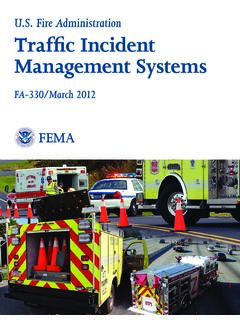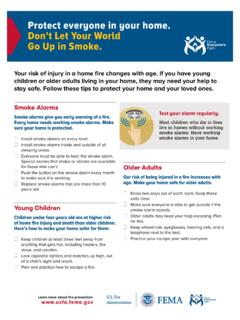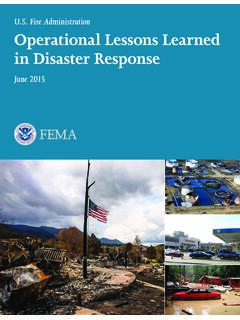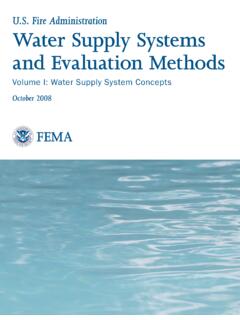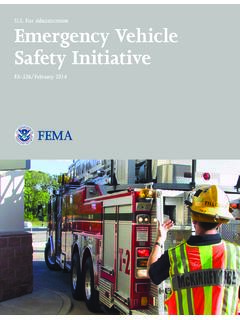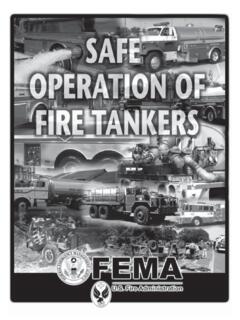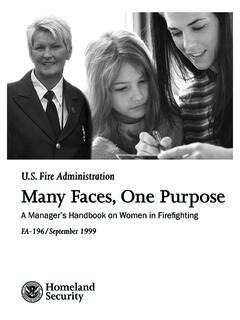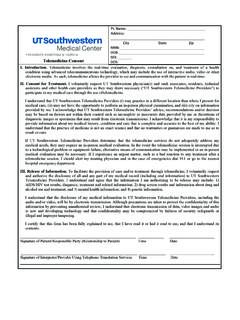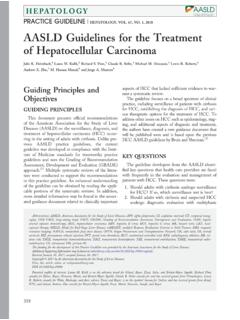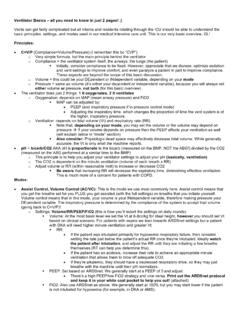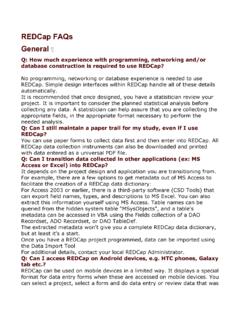Transcription of Operational Templates and Guidance for EMS Mass …
1 Operational Templates and Guidance for EMS mass incident DeploymentJu ne Fire AdministrationMission StatementWe provide National leadership to foster a solid foundation for our fire and emergency services stakeholders in prevention, preparedness, and for the Fire Administration (USFA) under Funding Opportunity Number DHS-10-USFA-105-000-04 by the National Emergency Medical Services Management Templates and Guidance for EMS mass incident DeploymentThis page was intentionally left expert review panel for this publication was composed of senior Emergency Medical Service (EMS) leadership from a broad domain of stakeholders. Each contributed time and expertise to ensure that the fi-nal publication was useful to local level emergency planners in the EMS sector.
2 Without their Guidance and commitment to developing a practical, accurate, and relevant set of tools, this document would not have made it out of the planning stages. A special thank you goes out to Aarron Reinert, Steve Delahousey, and Mike McAdams for preparing and presenting information of key interest during the meeting for this proj-ect. Without the input and Guidance from each stakeholder organization and their representatives on the expert review panel, this document would not have come to fruition. Finally, Federal partners Rick Patrick and Bill Troup provided background and Guidance as the project pro-gressed from idea to implementation. Expert Review PanelNational EMS Management Association: Project TeamSkip Kirkwood, NEMSMA President/Chief, Wake County EMSSean Caffrey, Project Manager/EMS Operations Program Manager, CDPHEJim Buell, Editor in Chief and Subject Matter Expert/Managing Partner, MTOG LLCK eith Hart, Subject Matter Expert/Senior Partner, MTOG LLCR osalind Cooper, Editor, Wheat Ridge, ColoradoJeff Dyar, Meeting Facilitator, The Far View Group, LLCA merican Ambulance AssociationSteve Delahousey, Vice President, American Medical ResponseCenter for Leadership Innovation and Research in EMSGary Wingrove, Director of Strategic Affairs, Mayo Medical TransportInternational Association of EMS ChiefsJames Robinson, Operations Chief.
3 Denver Health Paramedic DivisionNational Association of Emergency Medical TechniciansDon Lundy, EMS Director, Charleston County, South CarolinaInternational Association of Fire ChiefsJohn Sinclair, Fire Chief/Emergency Manager, Kittitas Valley Fire RescueInternational Association of Fire FightersLori Moore-Merrill, Assistant to the General PresidentInternational Association of Flight Kennedy, Program Manager/Assistant Vice President, Science Applications International Corporation (SAIC)National Association of EMS PhysiciansDr. Kathy Rinnert, Director GEMSS/EMS Fellowship Programs, university of texas southwestern at DallasDr. Brian Schwartz, Executive Lead, Sunnybrook-Osler Center for Prehospital CareOperational Templates and Guidance for EMS mass incident DeploymentiiNational Association of State EMS OfficialsJoe Schmider, EMS Director, State of PennsylvaniaNational Fire Protection AssociationKen Holland, Public Fire Protection ProgramsNational Highway Traffic Safety AdministrationGamunu Gam Wijetunge Office of Emergency Medical ServicesNational Volunteer Fire CouncilKen Knipper, Chair/EMS Rescue SectionSubject Matter ExpertsMike McAdams, Assistant Chief of Operations, Montgomery County Fire RescueAarron Reinert, National EMS Advisory Committee, Executive Director, Lakes Region EMSAl Martin, Fire Chief, City of Tuscaloosa.
4 Fire AdministrationBill Troup, Project OfficerUnited States Department of Health and Human ServicesJack Beall, Director, National Disaster Medical SystemUnited States Department of Homeland SecurityRick Patrick, Director, Medical First Response Coordination, Office of Health AffairsDr. Michael Zanker, MD, Senior Medical Officer, Office of Health AffairsTable of ContentsiiiTable of ContentsIntroduction ..1 SECTION I: Emergency Medical Services deployment Templates ..3 template 1: The Emergency Medical Services Emergency Operations Plan ..3 template 2: Basic Hazard Vulnerability Analysis ..6 template 3: incident and Event Plans ..9 template 4: Basic incident deployment Checklists ..14 SECTION II: mass Care Coordination Toolkit.
5 19 Introduction to the Coordination Planning Toolkit ..19 High School Football Game ..20 Residential Medical Facility Evacuation ..22 County Fair ..25 Marathon or Similar Running Events ..27 Weather-Related Disaster Declaration ..29 Large College Sporting Event ..31 Political Assembly ..34 Auto Racing/Competition ..36 Cancer Walk ..38 SECTION III: Case Studies in mass incident deployment ..41 Case 1: 2010 Bus Crash in Hartford, CT ..41 Case 2: 2005 F3 Tornado in Marshall County, KY ..43 Case 3: 2010 Veterans Administration Hospital Evacuation, Lebanon, PA ..46 Case 4: 2008 Imperial Sugar Dixie Crystal Plant Fire, Port Wentworth, GA ..49 Case 5: 2006 Woodward Dream Cruise, Berkley, MI ..52 Case 6: 2010 Ironman Triathlon Event, St.
6 George, UT ..55 Case 7: 2004 Democratic National Convention, Boston, MA ..57 Case 8: Annual Creation Music Festival, Mount Union, PA ..60 SECTION IV: Policy Guidance for mass Casualty Contingency Planning at mass Gathering Events ..63 Introduction ..63 Relationship of Event Command to Responding Resources ..67 Communications ..68 Expanded Scope/Emerging mass Casualty incident Management Considerations ..68 mass Casualty incident Planning Checklist ..71 incident Action Plan Safety and Risk Analysis, ICS Form 215A ..73 SECTION V: Policy Guidance for Emergency Medical Services Aspects of mass Shelter and Feeding ..75 Emergency Medical Services Participation in mass Shelter and Feeding ..75 Key Functional Roles and Tasks.
7 76 SECTION VI: Local Mutual Aid ..81 template : Local, Regional, and State Mutual Aid ..81 template : Inter-Local Government Agreement Mutual Aid ..83 ANNEX I: Sample Mutual Aid Agreements ..89 EXAMPLE: Single County Mutual Aid Agreement ..89 EXAMPLE: Single State Mutual Aid Compact ..93 Operational Templates and Guidance for EMS mass incident DeploymentivANNEX II: Sample mass Gathering Event Planning Tools ..111 Sample EMS Operations Plan ..113 Sample After Action Report ..121 Sample incident Action Plan ..127 ANNEX III: Emergency Management Assistance Compact ..135 EMAC Operational Considerations ..137 ANNEX IV: FEMA National Ambulance Contract ..141 FEMA National Ambulance Contract Operational Considerations.
8 143 ANNEX V: Intrastate Mutual Aid System ..145 ANNEX VI: National Disaster Medical System-Disaster Medical Assistance Teams ..149 ANNEX VII: References ..153 References and Reading List ..153 Introduction1 IntroductionProject BackgroundEmergency Medical Services (EMS) agencies regardless of service delivery model have sought Guidance on how to better integrate their emergency preparedness and response activities into similar processes occur-ring at the local, regional, State, tribal and Federal levels. The primary purpose of this project is to begin the process of providing that Guidance as it relates to mass care incident deployment . The World Bank reported in 2005 that on aggregate, the reported number of natural disasters worldwide has been rapidly increasing, from fewer than 100 in 1975 to more than 400 in 2005.
9 Terrorism, pandemic surge, and natural disasters have had a major impact on the science of planning for and responding to mass care incidents and remain a significant threat to the homeland. From the attacks of September 11th, 2001, the subsequent use of anthrax as a biological weapon, to the more recent surge concerns following the out-break of H1N1 influenza, EMS have a real and immediate need for integration with the emergency manage-ment process, and to coordinate efforts with partners across the spectrum of the response community. The barriers identified from the literature review and interviews with national EMS leadership include: lack of access to emergency preparedness grant funding; underrepresentation on local, regional, and State level planning committees; and lack of systematic mandatory inclusion of all EMS provider types in State, regional, and local emer-gency December 2004, New York university s Center for Catastrophe Preparedness and Response held a nation-al roundtable that included experts from major organizations representing the EMS system as a whole.
10 The report from that meeting concluded that: EMS providers, such as fire departments and hospital-based, commercial, and air ambulance services, ensure that patients receive the medical care they need during a terrorist attack. While EMS personnel, including Emergency Medical Technicians and para-medics, represent roughly one-third of traditional first responders (which also include law enforcement and fire service personnel), the EMS system receives only four percent of first responder funding. If EMS personnel are not prepared for a terrorist attack, their ability to provide medical care and transport to victims of an attack will be compromised. There will be an inadequate medical first 2007, the Institute of Medicine in its landmark report Emergency Medical Services at the Crossroads issued a rec-ommendation that stated:The Department of Health and Human Services (DHHS), the Department of Homeland Security and the States should elevate emergency and trauma care to a position of parity with other public safety entities in disaster planning and operations.

